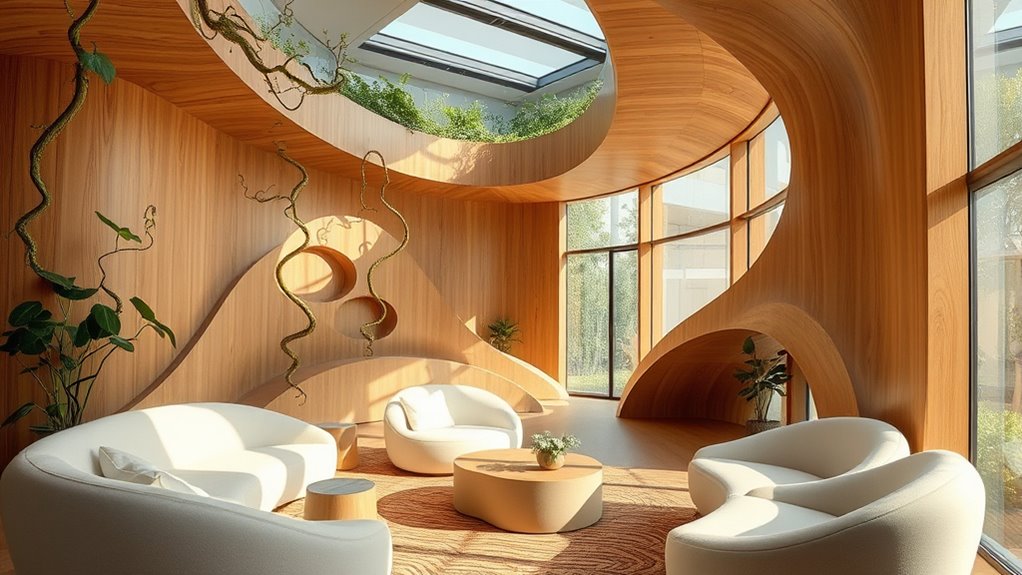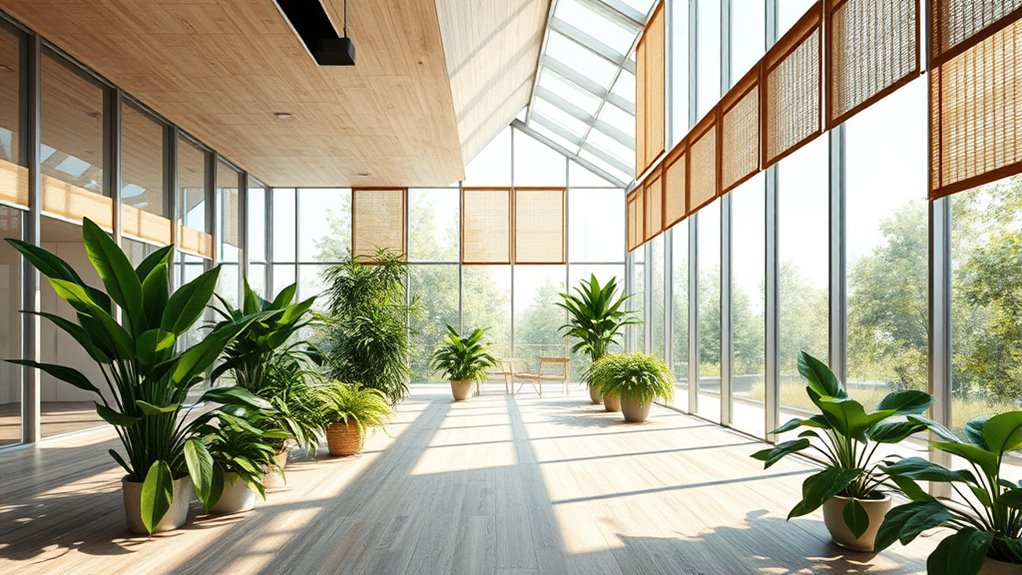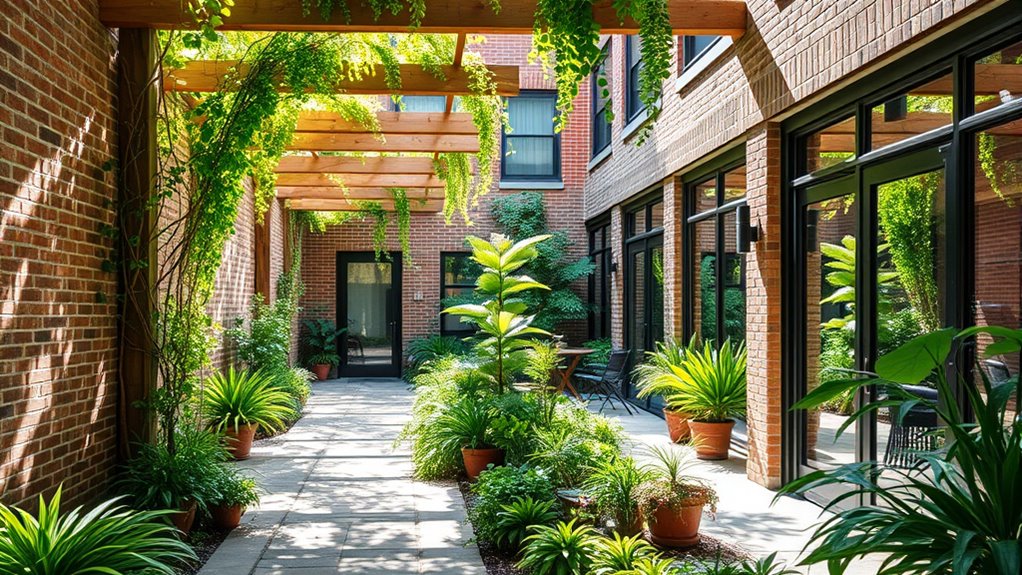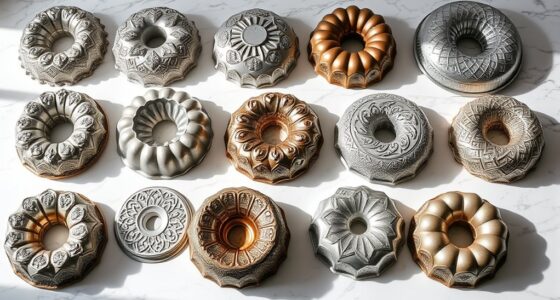To embrace biophilic design, focus on integrating natural environment features like greenery, water, and natural light. Use organic shapes and forms such as curves and flowing structures that mimic nature. Incorporate natural patterns and growth processes like fractals, spirals, and weathering to create visual harmony. Maximize light and spatial variability to enhance comfort. Connect your space to local contexts through regional materials and landscapes, fostering a deep human-nature bond. Keep exploring to uncover how these principles can transform your environment.
Key Takeaways
- Incorporate natural elements like greenery, water, and sunlight to foster a calming, restorative environment.
- Use organic shapes, flowing forms, and biomorphic structures to mimic natural growth and promote comfort.
- Mimic natural patterns such as fractals, spirals, and weathering to create visually engaging and authentic spaces.
- Maximize natural light through large windows and skylights, enhancing spatial variability and reducing artificial lighting.
- Connect environments to local ecological and cultural contexts using regional materials, landscape features, and indigenous design elements.
Emphasizing Natural Environment Features

Incorporating natural environment features into design creates a direct sensory link to nature that can substantially reduce stress and boost well-being. You can achieve this by integrating natural features like lush vegetation, water elements, and natural light to create inviting, restorative spaces. Utilizing natural materials such as wood and stone adds tactile comfort and biological textures that engage your senses. Designing with views of natural landscapes fosters a sense of tranquility and connection to the environment. Emphasizing site-specific natural features, like geological formations or local ecosystems, deepens your emotional attachment and sense of place. Including greenery on facades and outdoor habitats supports mental health by encouraging relaxation and reflection. Additionally, highlighting local ecosystems and sustainable practices in design emphasizes local sourcing and environmental responsibility. These elements work together to craft environments that nurture both your mind and body, especially as automation technologies increasingly influence building management and environmental controls. Understanding business trends can further enhance the integration of sustainable and biophilic elements in design projects. Incorporating natural plant life such as indoor gardens and living walls can further strengthen the biophilic connection within built environments.
Incorporating Organic Shapes and Forms

Incorporating organic shapes and forms helps your space feel more natural and calming by mimicking the curves and irregularities found in nature. You can use botanical motifs and flowing structures to strengthen that connection, making environments more inviting. Embracing these natural patterns encourages a seamless blend between built and natural environments. Additionally, integrating AI-powered design tools can assist in creating authentic organic forms through data-driven insights and generative design processes. These tools can help optimize design accuracy and ensure that the natural elements are both aesthetically pleasing and functional. Utilizing essential oils inspired by nature can further enhance the biophilic effect, promoting well-being and harmony within the space. Incorporating contrast ratio considerations into your design can help in creating visual depth and enhancing the overall atmosphere. Considering regional resources and tools, such as local botanical motifs or natural materials, can also enrich your design and foster a stronger connection to the environment.
Mimicking Natural Curves
Natural curves in design mimic the flowing, irregular patterns found in nature, making spaces feel more inviting and comfortable. By incorporating organic shapes and curved architectural elements like arches and rounded supports, you evoke natural forms that foster a biophilic environment. Biomorphic design uses these irregular patterns to replicate natural structures, enhancing aesthetic harmony and reducing visual stress. When furniture, walls, or spatial layouts feature natural curves, they create a sense of safety and refuge, aligning with how our brains respond to organic shapes. These curved elements reflect the complexity and variability of natural systems, helping occupants feel more connected to nature even indoors. Additionally, choosing appropriate headphone connections like Bluetooth or 3.5mm jacks can improve the overall experience when integrating technology into biophilic spaces. Incorporating natural materials such as wood, stone, and linen further enhances the organic feel of the environment. Recognizing the importance of biophilic design can deepen our understanding of how natural forms influence human well-being. Integrating cultural influences can help tailor biophilic environments to diverse preferences and traditions. Embracing natural curves ultimately promotes a sense of calm, comfort, and subconscious connection to the environment.
Using Botanical Motifs
Botanical motifs bring plant-inspired shapes, patterns, and symbols into designed spaces, creating a visual connection to nature that promotes calm and relaxation. By incorporating natural patterns and organic shapes—such as leaves, flowers, vines, spirals, and flowing curves—you enhance biophilic design and foster a sense of harmony with the natural environment. These plant-inspired forms add visual complexity, engaging your senses and subconsciously reinforcing your connection to nature. You might see botanical motifs in murals, textiles, sculptures, or structural elements, subtly embedding nature into everyday spaces. Using these motifs not only elevates aesthetic appeal but also supports mental well-being by creating environments that evoke the soothing qualities of the natural world, making your space feel more inviting and restorative. Incorporating interior design principles can further optimize how these motifs influence the overall ambiance of your space. Additionally, understanding IRA investment strategies can help in planning financial aspects to support a lifestyle that embraces biophilic design. Moreover, paying attention to sustainable materials ensures that the use of botanical motifs aligns with environmentally conscious practices. Incorporating natural lighting can further enhance the calming effects of botanical motifs and promote overall well-being. Introducing regional plant species into your design can also strengthen the local connection and authenticity of your space.
Creating Organic Architectures
Have you ever noticed how shells, leaves, and flowing rivers inspire the shapes of beautiful buildings? Incorporating organic shapes and natural forms creates environments that feel familiar and comforting. Biomorphic design uses arches, vaults, and curved supports to enhance visual interest while fostering harmony with nature. These natural patterns often embrace asymmetry and variability, reflecting ecosystems’ complexity and promoting sensory engagement. Organic architecture improves spatial flow and circulation, making spaces more intuitive and inviting. By mimicking environmental features through biomimicry, you support sustainable design, utilizing natural patterns that replicate efficient, nature-based systems. This approach not only enhances aesthetic appeal but also aligns your structure with biophilic architecture principles, creating spaces that truly connect people with the natural world. Additionally, understanding the best free keto diet app can inspire sustainable and health-conscious design choices that promote well-being. Recognizing the importance of natural forms in design encourages architects to incorporate these principles more consciously into their projects, emphasizing the significance of biophilic design in creating harmonious environments. Incorporating noise reduction technology into building design can further enhance comfort by minimizing disturbances from external environmental factors.
Utilizing Patterns and Growth Processes From Nature

You can incorporate natural growth patterns like fractals and spirals to create environments that feel both complex and harmonious. Mimicking structures such as branching supports or honeycomb patterns enhances efficiency and sensory engagement. By embracing these natural processes, your designs become more dynamic and connected to the cycles of nature.
Emulating Natural Structures
Emulating natural structures in design involves mimicking the shapes and growth patterns found in nature to create visually engaging and harmonious environments. By incorporating natural patterns and biomimicry, you can craft organic forms that mirror natural shapes like spirals, shells, and honeycombs. These elements reflect natural aging and weathering, adding authenticity through textures that evoke weathered steel or stone. Using fractals and branching patterns introduces complexity and harmony, fostering sensory engagement through variability in light, texture, and form. When you emulate natural structures, you foster a subconscious connection to nature, promoting feelings of tranquility, resilience, and vitality within your space. This approach creates environments that feel both authentic and inspiring, seamlessly blending built and natural worlds.
Incorporating Growth Patterns
Incorporating natural growth patterns into design creates dynamic and soothing environments that resonate with our innate connection to nature. By mimicking natural processes like weathering, plant succession, and aging, you foster a sense of harmony and temporal connection. Using materials such as weathering steel or reclaimed wood emphasizes natural growth and change, enriching the space’s storytelling. Designs that reflect growth patterns, like spiral motifs or layered arrangements, enhance sensory engagement and invite exploration. These elements support the biophilic principle of mirroring the complexity and variability of the natural world. When you integrate these patterns, you create environments that feel alive, fostering well-being through visual cues of natural processes and ongoing evolution. This approach deepens your connection to nature, promoting a sense of calm and continuity.
Maximizing Light and Spatial Variability

Maximizing light and spatial variability involves designing interiors that harness natural illumination and create dynamic environments. You should prioritize large windows, skylights, and open spaces to maximize natural light, supporting circadian rhythms and boosting mood. Incorporate diffused and reflected light to produce subtle variations and dynamic shadows, mimicking outdoor lighting conditions. Vary interior volumes—think high ceilings or cozy alcoves—to evoke outdoor spatial experiences like open skies or refuges. Using multiple lighting layers—ambient, task, and accent—adds richness and sensory engagement to your space. These strategies improve visual comfort and reduce dependence on artificial lighting, lowering energy consumption. By thoughtfully combining natural light and spatial variability, you’ll craft environments that feel alive, inviting, and aligned with nature’s rhythms.
Building Connections to Local Contexts

Building strong connections to local contexts begins with understanding the unique cultural, ecological, and historical features of your site. Incorporate local materials, landscape features, and indigenous design techniques to create environments that resonate with their surroundings. Emphasize place-based design by integrating natural elements like native plants and regional geological features, reinforcing the ecological context. Using these elements fosters a sense of cultural relevance and deepens emotional attachment. Recognizing and embedding regional characteristics enhances community identity and supports sustainability. By reflecting the distinctive biogeographical and cultural narratives through local art, architecture, and landscape patterns, you ensure the space authentically mirrors its environment. This approach not only promotes environmental harmony but also cultivates a meaningful human-nature connection rooted in the site’s unique identity.
Fostering Innate Human-Nature Bonds

Have you ever wondered why natural environments evoke a sense of calm and well-being? It’s because of our innate human-nature connection, rooted in biophilic design. This connection to nature is driven by biophilic principles that incorporate natural elements like water, sunlight, and greenery, which reduce stress and boost mood. Our evolved affinity for natural forms—such as patterns and landscapes resembling the savanna—strengthens this bond. By integrating biophilic elements, you foster a deeper human-nature bond that satisfies psychological needs for prospect and refuge. These natural forms and elements tap into our biological predisposition, creating environments where you feel more relaxed, focused, and connected. Embracing biophilic design helps nurture this innate bond, enriching your space with nature’s calming influence.
Applying Design for Multiple Scales and Contexts

Applying biophilic design across multiple scales requires tailoring natural elements to fit the specific context, whether in small interiors or expansive outdoor spaces. In interior design, you can enhance connectivity to nature with natural textures, view windows, and indirect lighting, creating a calming environment regardless of size. At the building scale, incorporating natural shapes, materials, and daylighting strengthens the connection to the built environment and supports occupant well-being. In urban planning, designing green corridors, parks, and naturalized streetscapes promotes ecological relationships and community health. Adaptive design considers local climate, culture, and natural features to guarantee interventions are sustainable and appropriate for each context. By adjusting natural elements to scale and environment, you create restorative spaces that foster human-nature connections across diverse settings.
Frequently Asked Questions
What Are the 6 Principles of Biophilic Design?
You ask about the six principles of biophilic design. You’ll focus on integrating environmental features like plants, water, and natural materials to stimulate your senses. You’ll incorporate natural shapes, forms, and patterns inspired by nature. You’ll consider light and space to create a comfortable atmosphere. You’ll build place-based relationships by connecting your environment to local culture and ecology. Finally, you’ll foster evolved human-nature relationships to promote well-being and a sense of belonging.
What Are the 5 Senses of Biophilic Design?
You explore the five senses in biophilic design by engaging sight, sound, smell, touch, and taste. You notice natural light and colors that boost your mood, hear water or bird sounds that relax you, smell fresh plants or essential oils that influence your feelings, touch natural textures that connect you to nature, and even experience tastes of natural foods. These elements create a multisensory connection that enhances your well-being and comfort.
What Are the Pillars of Biophilic Design?
Think of biophilic design pillars as the roots anchoring a tree, grounding your space in nature. These pillars—environmental features, natural shapes, patterns, light and space, and place-based relationships—work together to create a harmonious environment. You incorporate natural elements, mimic organic forms, and honor local context, enriching your space with significance. By doing so, you foster well-being and deepen your connection to nature, transforming your environment into a restorative haven.
Who Wrote the 14 Patterns of Biophilic Design?
You’re wondering who authored the 14 Patterns of Biophilic Design. These patterns were developed through extensive research by Terrapin Bright Green, led by biophilic design expert Stephen Kellert. They result from collaboration among scientists, architects, and environmental psychologists, aiming to translate biophilia concepts into practical design strategies. You can rely on these patterns to create spaces that promote well-being by fostering a stronger connection with nature.
Conclusion
By embracing these biophilic design principles, you create spaces that truly connect people with nature. Did you know that environments with natural elements can reduce stress by up to 30%? Incorporating organic shapes, maximizing natural light, and building local connections not only enhance well-being but also boost productivity. When you design with nature in mind, you’re fostering innate human bonds, making your space healthier, more inspiring, and more sustainable for everyone.









